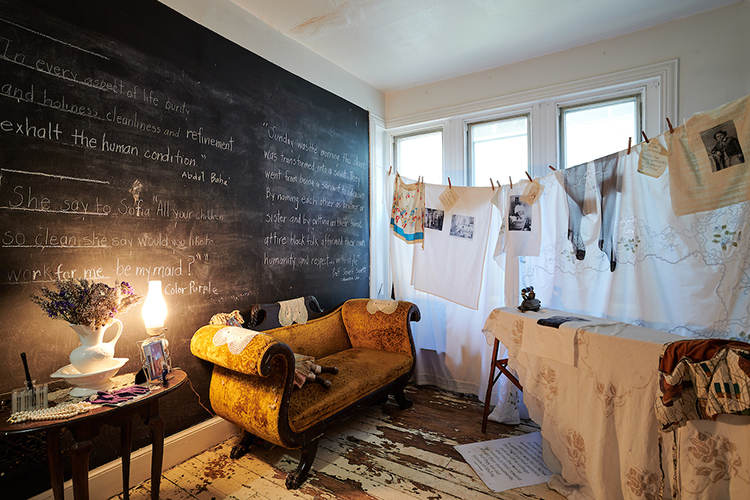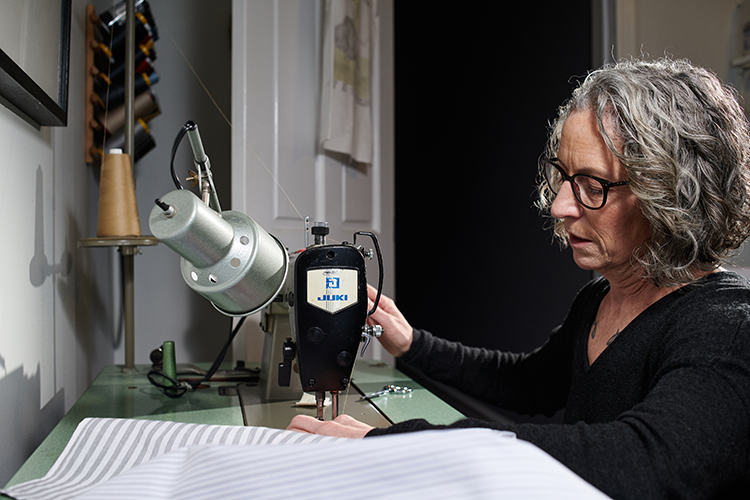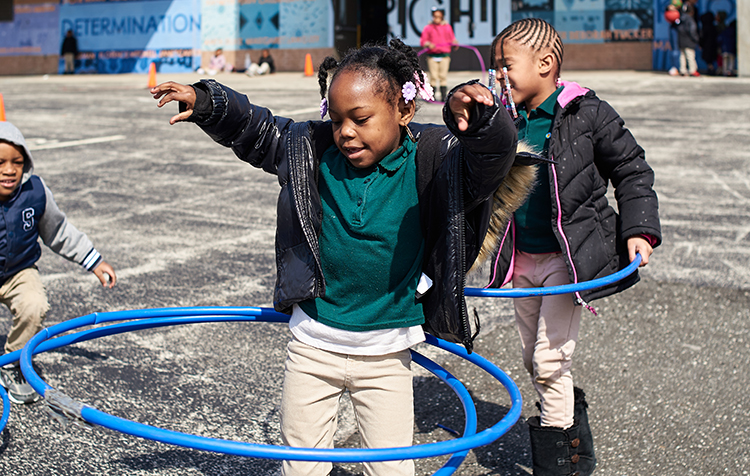by Claire Marie Porter
Reborn with the help of blood, sweat and compost, a set of abandoned tennis courts in Germantown have been given a new lease on life.
Owned by Germantown Friends School, the half-acre plot of land at 5407 Wissahickon Avenue containing the Old Tennis Court had sat unused since the 1980s.
That is, until 2006, when community members embarked on a journey to cut up the court’s playing surface and sift and till the soil underneath. By 2009 they’d turned the overgrown athletic field into a functioning community garden.
“It was ugly work,” says garden member Mary Ellen Krober. There were mountains of debris.
Eventually, they built 48 12-by-12 plots and a solar-powered water-access system in an area where over 20 percent of the residents live under the poverty line. Four of those plots grow produce exclusively for the Whosoever Gospel Mission, which serves 80,000 meals a year to food-insecure communities in Philadelphia.
“This is our neighborhood, and well-maintained, productive green space is a benefit to a neighborhood and a community,” says gardener Mark Kearney. “In addition to growing food, for many, the garden is a means of exercise, being outdoors, accomplishment, productivity, pride, feeling good, meeting new people, socializing, collaborating with others and contributing to the community.”
It was all going well until 2015 when Germantown Friends announced its intention to sell the parcel to developers. The garden shuttered in October of that year, and the land was put on the market for $250,000—a sum far out of the community’s reach.
Urban Pioneers
The Old Tennis Court Farm is a microcosm of land trends in Philadelphia—a neat package of land insecurity, neighborhood disinvestment, and community effort and resourcefulness.
Vacant lots are a chronic part of our local landscape. As has been well-documented by the city, more than 40,000 plots of land, mostly in disinvested areas, sit unused and long neglected by remote landowners or the city. Sometimes the land has no owner at all.
Left alone, these lots often become garbage heaps. But many neighborhoods have transformed them into treasured community resources by removing trash and planting flowers and gardens.
Rooted in black and brown communities’ resistance to neglect and injustice, the produce grown on these lots often serves as an antidote to food deserts and food insecurity.
The gardens vary in size and character. Where some span several square feet, others span several acres. Some are considered historical land and others tax-delinquent dumping grounds between row homes. Few gardens are permanent, and although some have managed a year-by-year lease, many have no security in the face of rapid gentrification and development.
Jenny Greenberg, executive director of Neighborhood Garden Trust (NGT), estimates that of the 300 working community gardens in Philadelphia, 200 are at risk of loss to development or being auctioned off in a Sheriff’s sale.
“Despite the environmental, social, health, and economic benefits these gardens provide,” Greenberg says, “many are at-risk because they are owned by the city or private property owners who abandoned them.”
Developers now see dollar signs in these long abject spaces, putting these thriving community gardens under threat. Because growers and neighbors can’t afford to outbid developers, the gardens they have painstakingly cultivated are at risk of being paved over.
A Whole Lot of Luck
The Old Tennis Courts community found the key to their secret garden this winter.
Joining forces with the Friends of Cloverly Park, an all-volunteer committee dedicated to caring for Fairmount Conservancy’s two-acre thumbprint, which runs adjacent to the garden, the Germantown residents hoped to procure the land for themselves. Ellen Wert, co-president of the committee, contacted a regional land conservancy called Natural Lands and the NGT. Soon, a partnership began.
“The gardeners themselves have been remarkably sophisticated about what they needed to do to make this happen,” says the vice president of conservation services at Natural Lands, Peter Williamson, who also sits on the board of directors at NGT.
NGT handled the logistics of the sale, and Natural Lands signed on to protect the land in perpetuity through a conservation easement.
The groups facilitated a three-way transaction, wherein Natural Lands purchased the land from Germantown Friends and transferred ownership to NGT. The city, community leaders, city council members, and state representatives and senators got behind the application, says Greenberg.
A $225,000 grant from the state’s Greenways, Trails and Recreation program covered 85 percent of the market price, but the gardeners needed to gather the remaining funds.
“They agreed and raised money locally to do it,” says Williamson.
The gardeners went to every conceivable organization to request donations.
While the issue of land insecurity of long standing community space is common, Greenberg says, what’s unique about this garden is the size and expense of the parcel, and the zealous, grassroots organizing of the community.
As the plans slowly unfurled in the community’s favor, neighbors watched the trees and fields across the street from the garden turn into a high-rise complex.
“That could’ve been us,” says Hap Haven, a gardener whose home backs up against the lot.
Next to the garden plots, a fire pit made of the tennis courts’ macadam is all that remains of the space’s previous life—a nod to years of toil and the communal lift.
Growing Community Trusts
As the city’s largest land trust, the NGT works with land-holding agencies and private landowners to keep land in the hands of Philadelphians. To date the organization has protected 45 open spaces, and it aims to bring that number up to 70 by 2022, according to Greenberg.
But securing land in Philadelphia is rarely this straightforward. While the Old Tennis Court Farm was saved due to assertive and resourceful neighbors, it was also a matter of good fortune. Given the limited number of available land grants, the willingness of the land owner not to sell to the highest bidder and the savviness of the community at large, this is not a blueprint for most of the 200 vulnerable gardens in the city.
In 2015 Penn State’s College of Agricultural Sciences conducted an urban gardening study.
“Leasing or buying public or private land has proven to be a complex issue, even in a city like Philadelphia with a wealth of vacant land at its disposal,” the report concluded, citing obstacles like inadequate lease contracts, gentrification, bureaucracy and a slew of legal barriers.
“Most growers don’t even know they ha
ve rights to the land they’ve cared for,” says Ebony Griffin of Public Interest Law Center.
For most communities, raising the money to buy a parcel of land is unrealistic. The center’s major role is providing pro bono legal representation for growers and gardeners in the city.
“The inaccessibility of knowledge is part of the problem,” says Sonia Galiber of Urban Creators, a North Philadelphia nonprofit that founded Life Do Grow urban farm. Trying to understand how money and power flow through the city is difficult, she says.
Thinking of urban gardening as a trend or newly invented “hipster hobby” is inaccurate and counterproductive to the urgency of the narrative, Galiber continues. It overlooks the rich history of black farming in the city as a response to perpetual under-investment.
“As if poverty just happens,” she says.
Organized under the name “Take Back Vacant Land,” a campaign of about 50 faith and labor groups passed a law in January 2014 that gives communities control over the vacant lots in their neighborhoods. The campaign is dedicated to holding the city accountable to that legislation.
One of the best resources available, says Griffin, is Vacant Land 215, a regularly occurring community education event, next happening April 11. Land Bank, NGT, Philadelphia Horticultural Society and Soil Generation, a black-and-brown-led coalition that advocates for urban growers, are jointly hosting the meeting and will be sharing resources for urban farmers.
“We encourage people to be proactive,” says Griffin, adding that it’s much harder to make a case for ownership in a reactionary situation.
She cites La Finquita “little farm” garden, as an example.
A thriving farm in North Philadelphia since the ’80s, it was padlocked without notice, and eventually sold for townhouse development in 2018. By the time the sale went through, it was too late to respond, says Griffin. She references adverse possession, or “squatter’s rights,” the legal principle that if you’ve been possessing vacant land for a certain amount of time, you can gain control over it.
Trying to retroactively prove that possession is difficult, so she urges growers to know their rights ahead of time, so claims can be filed and gardens can be saved.
“Gardening,” says Galiber, “is the direct result of people figuring out how to deal with injustice themselves.”







